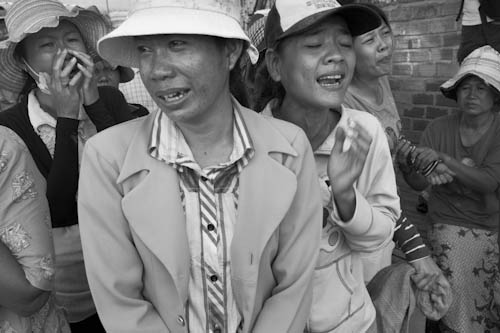Among the first things I photographed when I decided to move to Cambodia in 2000 was a demonstration by a small group of people in front of the National Assembly. It was obvious that these weren’t “city people.” They were people who had been evicted from their land and who had come to seek parliamentary support in reclaiming their property. I was hooked… That would be the beginning of eleven years of work dealing with land issues. The war, the atrocities of the Khmer Rouge genocide, the civil war: it all seemed so distant twenty-one years after the fall of the Khmer Rouge and nine years after the signing of the Peace Accords. But the scars were deep and left many traces, including the disappearance of all land records after Pol Pot abolished property in 1975.
This absence, combined with 2-digit economic growth in the early 2000s brought on by a runaway free market, resulted in a rush for land. In a fledgling democracy where corruption is rampant, the arrogance of the powerful and the power of money have had terrible consequences on the land. In Phnom Penh alone, 10% of the population (150,000 people) were evicted from their land in the past ten years, in most cases without adequate financial compensation. Four million hectares, 22% of the country’s land, was given to private companies as an economic concession. As a result, the people living on those lands often lost their means of income.
Anyway, I found myself faced with a subject similar to what I have photographed for the past forty years, almost always in post-chaotic situations: upheaval, belonging, social injustice, development, reconstruction, life without a voice.
The arrival of the iPad came at the perfect time to present this story. Condensing eleven years of work into a ‘normal’ book would have required me to leave out so much information that is essential to understanding this phenomenon of evictions and the mechanisms that govern it.
The iPad application contains: more than 700 photographs divided into 20 chapters covering not only the evictions themselves, but also their history and consequences; twenty-one thousand words of text (not including captions); soundtracks for the slideshows; and links to reports by NGOs involved in the defense of human rights in Cambodia. Another advantage of ‘Quest for Land’: previous versions will be supplemented free of charge with photographs taken since their release.
So there’s no reason for me to stop documenting these evictions in Cambodia.
John Vink Phnom Penh, Mai 31st, 2012
















